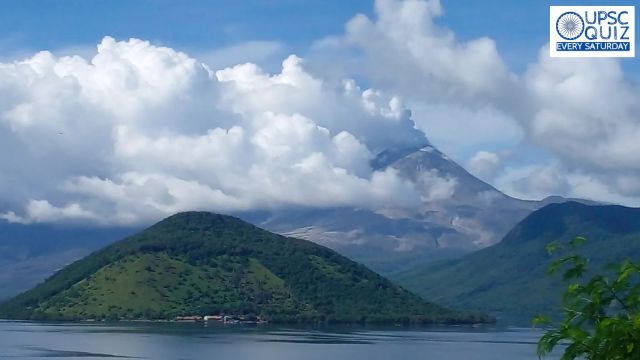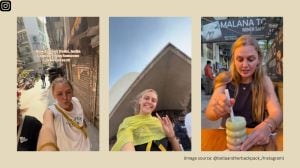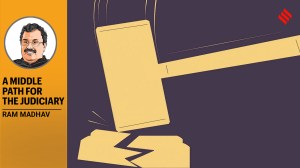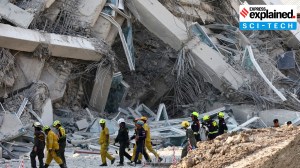UPSC Weekly Current Affairs Quiz | March 16 to March 22, 2025
Brush up your current affairs knowledge with this week's top 15 questions and consolidate your UPSC-CSE preparation. Find answers along with explanations.
 Brush up your current affairs knowledge with this week's top 15 questions. Find a question on the Mount Lewotobi Laki-Laki in today's quiz. (AP Photo/Ester Narek)
Brush up your current affairs knowledge with this week's top 15 questions. Find a question on the Mount Lewotobi Laki-Laki in today's quiz. (AP Photo/Ester Narek)UPSC Weekly Quiz is a current affairs-based quiz on relevant topics from the past week, curated for the aspirants of competitive examinations. Attempt the weekly quiz every Saturday and find answers to the MCQs with explanations.
🚨 Click Here to read the UPSC Essentials magazine for March 2025. Share your views and suggestions in the comment box or at manas.srivastava@indianexpress.com🚨
QUESTION 1
Consider the following statements:
Statement 1: Among vertebrates, lizards and snakes can raft farther than mammals.
Statement 2: The faster metabolism of lizards and snakes allows them to fast for a long time.
Which one of the following is correct in respect of the above statements?
(a) Both Statement 1 and Statement 2 are correct and Statement 2 is the correct explanation for Statement 1.
(b) Both Statement 1 and Statement 2 are correct and Statement 2 is not the correct explanation for Statement 1.
(c) Statement 1 is correct but Statement 2 is incorrect.
(d) Statement 1 is incorrect but Statement 2 is correct.
Explanation
— For decades, the native iguanas of Fiji and Tonga have posed an evolutionary conundrum. Every other living iguana species lives in the Americas, ranging from the southern United States to the Caribbean and parts of South America.
— Such a journey across approximately 8,000 km of open ocean would be the longest known by any non-human creature.
— Rafting, the term scientists use to describe catching a ride across oceans on uprooted trees or tangles of vegetation, has long been acknowledged as a means for small species to reach islands. However, this is common in invertebrates, whose small size allows them to survive a considerable distance in an uprooted tree trunk.
— Among vertebrates, lizards and snakes seem to be able to raft farther than mammals, perhaps because their slower metabolism allows them to fast for a long time.
Therefore, option (c) is the correct answer.
QUESTION 2
With reference to the collegium, consider the following statements:
1. It is the system by which judges of the higher judiciary in India are appointed and transferred.
2. It is rooted in the Constitution of India.
3. The Supreme Court collegium is a three-member body.
How many of the statements given above are correct?
(a) Only one
(b) Only two
(c) All three
(d) None
Explanation
— After a meeting on Thursday evening (March 20), the Supreme Court collegium unanimously resolved to return Delhi High Court judge Justice Yashwant Varma to the Allahabad High Court, where he was originally from.
— Collegium is the method for appointing and transferring judges of India’s higher courts, including the Supreme Court and High Courts. Hence, statement 1 is correct.
— Although not based on the Constitution or any specific statute enacted by Parliament, it has evolved over time through Supreme Court decisions known as “Judges Cases”. Hence, statement 2 is not correct.
— The Supreme Court collegium is a five-member body headed by the incumbent Chief Justice of India (CJI), and comprising the four other seniormost judges at that time. Hence, statement 3 is not correct.
— The SC collegium proposes judges for appointment to the Supreme Court. HC collegiums also exist (for their various High Courts), albeit their proposals must be approved by the SC collegium.
— These suggestions reach the government, whose role in the process is limited to completing an Intelligence Bureau (IB) investigation of the recommended individuals. While the government may dispute and request clarity on the collegium’s choices, it is required by Constitution Bench decisions to approve the candidates if the collegium reiterates them.
Therefore, option (a) is the correct answer.
QUESTION 3
To which of the following Mughal emperors did the historian William Dalrymple called “a depressingly puritanical figure”?
(a) Humayun
(b) Babur
(c) Shahjahan
(d) Aurangzeb
Explanation
— On Thursday (March 20), three days after deadly riots in Nagpur, the curfew was removed in several districts of the city. The Vishva Hindu Parishad (VHP) and other Hindutva organisations want the Mughal emperor Aurangzeb’s tomb demolished, which is at the centre of the unrest.
— Aurangzeb died more than 300 years ago, on February 20, 1707. He governed for nearly 50 years, making him the longest-serving emperor of one of the world’s most powerful dynasties.
— Aurangzeb spent the final years of his life as his huge kingdom crumbled around him. He was suffering an agrarian crisis, the nobility was gradually abandoning him, and he was militarily surrounded by the increasingly powerful Marathas. Aurangzeb died while on a campaign against the Marathas in the Deccan, when he was about 90 years old.
— Aurangzeb is recognised as a religious zealot, whom historian William Dalrymple described as “a depressingly puritanical figure”. However, he was a man of contrasts, as evidenced by his grave.
Therefore, option (d) is the correct answer.
QUESTION 4
With reference to the solstices, consider the following statements:
1. It marks the days when the Earth is extremely tilted toward or away from the sun.
2. The summer solstice in the Southern Hemisphere is between June 20 and 22.
Which of the statements given above is/are correct?
(a) 1 only
(b) 2 only
(c) Both 1 and 2
(d) Neither 1 nor 2
Explanation
— The solstices are the days when the Earth is highly inclined towards or away from the Sun. On these days, the sun provides considerably different amounts of light and warmth to each hemisphere, with similarly unbalanced days and nights. Hence, statement 1 is correct.
— The summer solstice in the Northern Hemisphere, which occurs between June 20 and 22, marks the longest day and shortest night of the year, as the upper half of the globe tilts towards the sun. Hence, statement 2 is not correct.
— In contrast, the winter solstice in the Northern Hemisphere, which occurs between December 20 and 23, marks the shortest day and longest night of the year, with the upper half of the earth tilted towards the sun.
Therefore, option (a) is the correct answer.
QUESTION 5
Daniel Kahneman, a renowned psychologist, one year after his death was in the news for the ethics of assisted dying. He won:
(a) Noble Peace Prize, 2004
(b) Nobel Prize in Physiology or Medicine, 2002
(c) Sveriges Riksbank Prize in Economic Sciences, 2002
(d) Nobel Prize in Physiology or Medicine, 2004
Explanation
— Daniel Kahneman, a famous psychologist who received the 2002 Sveriges Riksbank Prize in Economic Sciences (often known as the “Nobel Prize in Economics”), died in March 2024. However, one year later, his death has reignited a long-running issue in many countries: the ethics of assisted dying.
— The circumstances behind Kahneman’s death at the age of 90 were unknown to the public at the time, since his family refused to divulge information. Jason Zweig, Kahneman’s former collaborator and journalist, wrote about his death by assisted suicide at a Swiss institution in an editorial published in The Wall Street Journal on Friday (March 14).
— He was awarded the Sveriges Riksbank Prize in Economic Sciences “for having integrated insights from psychological research into economic science, especially concerning human judgment and decision-making under uncertainty”.
Therefore, option (c) is the correct answer.
QUESTION 6
The term “Challenger 150” was in the news recently. It refers to:
(a) programme to detect and map water on the surface
(b) initiative for deep-sea research
(c) initiative for protecting the rights of children in India
(d) conducting successful autonomous landing trials of a high-speed flying-wing UAV
Explanation
— A team of scientists may have discovered hundreds of new species, including giant sea spiders, octopi, and corals, on the newly exposed bottom left by the massive A-84 iceberg that broke off from the George VI Ice Shelf.
— The voyage was part of Challenger 150, a UNESCO-supported global project for deep-sea research. The findings shed new light on how ecosystems function beneath floating parts of Antarctic ice.
— Scientists spent eight days exploring the bottom with the remotely operated vehicle (ROV) SuBastian, discovering healthy habitats at depths of up to 1,300 metres.
— Their observations include huge corals and sponges that sustain a variety of animal life, including icefish, giant sea spiders, and octopus. They also discovered a big phantom jelly, a type of jellyfish that may grow to be a metre wide, and a vase-shaped sponge that could be hundreds of years old. Scientists claim they may have discovered numerous new species.
Therefore, option (b) is the correct answer.
QUESTION 7
With reference to the Demand for Grants, consider the following statements:
1. It is not mentioned in the Constitution of India.
2. The Bill associated with the Demands for Grants cannot be passed without a discussion.
Which of the statements given above is/are correct?
(a) 1 only
(b) 2 only
(c) Both 1 and 2
(d) Neither 1 nor 2
Explanation
— The Lok Sabha approved the Demand for Grants of various ministries for the fiscal year 2025-26, which totalled more than Rs 50 lakh crore. The Demand for Grants was passed by the Lok Sabha using the guillotine method.
— Applying guillotine means that the Demands for Grants for the ministries to whom it is applied are considered granted without discussion. Hence, statement 2 is not correct.
— It is mentioned in the Article 113 of the Constitution of India. No claim for a grant shall be made unless on the President’s recommendation. Hence, statement 1 is not correct.
— Estimates for expenditure charged to the Consolidated Fund of India will not be put to the vote of Parliament.
— Estimates for additional expenditures must be submitted to the House of the People in the form of grant demands.
Therefore, option (d) is the correct answer.
QUESTION 8
With reference to the Composite Landscape Assessment and Restoration Tools (CLART), consider the following statements:
1. It is a Geographic Information System (GIS) based Android tool.
2. It helps rural communities in the recharge of ground water or augment surface water availability.
Which of the statements given above is/are correct?
(a) 1 only
(b) 2 only
(c) Both 1 and 2
(d) Neither 1 nor 2
Explanation
— Around 20 kilometres from Jharkhand’s Giridih district seat, alleyways in the rural village of Jitkundi lead to a big reservoir whose greyish-blue water reflects an orange tinge from the setting sun. This reservoir, nestled in the midst of undulating hills, altered the entire hamlet landscape.
— The reservoir, built in 2023 as part of the NITI Aayog Rejuvenation Window-II, is one of 5,132 water bodies scheduled for rejuvenation in the district. The construction, which was meticulously planned and built using CLART, a Geographic Information System (GIS) technology that aids in soil and water conservation, traps precipitation in the reservoir during the monsoon season.
— CLART is a Geographic Information System (GIS)-based Android program designed to help plan region-specific soil and water conservation measures. Hence, statement 1 is correct.
— CLART enables rural communities to create measures that will either help replenish ground water or increase surface water availability, depending on the location’s geo-hydrological characteristics. Hence, statement 2 is correct.
Therefore, option (c) is the correct answer.
(Other Source: http://www.indiaobservatory.org.in)
QUESTION 9
Mount Lewotobi Laki-Laki was recently in the news. It is located in:
(a) Philippines
(b) United States
(c) Australia
(d) Indonesia
Explanation
— At least seven international flights from Indonesia’s resort island of Bali have been cancelled, according to an airport official, after a volcano erupted in the archipelago nation, spewing ash clouds over 8 kilometres high and prompted authorities to elevate the alert level to its highest.
— Mount Lewotobi Laki-Laki, a 1,703-meter (5,587-foot) twin-peaked volcano on Indonesia’s Flores Island, erupted for more than 11 minutes late Thursday, forcing authorities to boost its alert level to the highest.
Therefore, option (d) is the correct answer.
QUESTION 10
Consider the following statements:
1. Netumbo Nandi-Ndaitwah was sworn in as the first female president of a country marking a historic moment.
2. Her inauguration coincided with the country’s 35th independence anniversary.
3. She is the fifth president of the country.
The country mentioned in the above statements refers to:
(a) South Sudan
(b) Algeria
(c) Namibia
(d) Ghana
Explanation
— Namibia’s first female president, Netumbo Nandi-Ndaitwah, was sworn in on Friday, a historic occasion for the country. Her inauguration coincided with Namibia’s 35th independence anniversary.
— Nandi-Ndaitwah, 72, takes office as Namibia’s fifth president, succeeding Nangolo Mbumba, who had served as interim president following Hage Geingob’s death in February 2024.
— The ceremony was attended by several African leaders, including those from South Africa, Zambia, Congo, Botswana, Angola, and Kenya, as well as Tanzanian President Samia Suluhu Hassan and former Liberian presidents Ellen Johnson Sirleaf and Joyce Banda of Malawi.
Therefore, option (c) is the correct answer.
QUESTION 11
Consider the following statements with reference to the international relations:
1. “Five Eyes” refers to an intelligence-sharing alliance of the United States, United Kingdom, Australia, Japan and New Zealand.
2. The theme of the Raisina Dialogue 2025 edition is “Kālachakra – People, Policies and Planet”
3. The Raisina Dialogue is organized by the Observer Research Foundation in collaboration with the Ministry of External Affairs, Government of India.
Which of the statements given above is/are not correct?
(a) 1 and 2 only
(b) 1 only
(c) 2 and 3 only
(d) 1, 2 and 3
Explanation
— The Raisina Dialogue is an annual conference focused on geopolitics and geoeconomics. It aims to address some of the most pressing issues facing the world today. The conference is held in New Delhi and attracts participants from various sectors, including politics, business, media, and civil society.
— According to the website of Raisina Dialogue, “the Dialogue is structured as a multi-stakeholder, cross-sectoral discussion, involving heads of state, cabinet ministers and local government officials, who are joined by thought leaders from the private sector, media and academia.”
— The dialogue is organized by the Observer Research Foundation in collaboration with the Ministry of External Affairs, Government of India.
— The 10th edition of the Raisina Dialogue will be held from 17-19 March, 2025. The theme of the 2025 edition is “Kālachakra – People, Peace and Planet”, according to a press release by the Ministry of External Affairs.
— The recent gathering in New Delhi on Sunday (March 16) signalled strong cooperation on security issues, with US Director of National Intelligence Tulsi Gabbard, UK National Security Advisor Jonathan Powell, and New Zealand’s intelligence chief Andrew Hampton joining intelligence leaders from various countries.
— The conference, organised by the National Security Council Secretariat, was hosted by India’s National Security Advisor Ajit Doval, R&AW chief Ravi Sinha, and Intelligence Bureau director Tapan Deka. This important meeting included key representatives from at least three of the Five Eyes partners highlighting the close security and intelligence collaboration between New Delhi and its allies.
— India has hosted this conference since 2022, when the intelligence chiefs began meeting informally on the sidelines of the Raisina Dialogue. “Five Eyes” refers to an intelligence-sharing alliance of the United States, United Kingdom, Australia, Canada and New Zealand. It was formed during World War II.
Therefore, (a) is the correct answer.
QUESTION 12
If the euro is strengthening against the dollar, it may:
1. reduce inflation because India imports the bulk of its crude oil requirement in dollars.
2. help Indian exports to the euro area.
Which of the above given statements is/are true?
(a) 1 only
(b) 2 only
(c) Both 1 and 2
(d) Neither 1 nor 2
Explanation
— The euro is strengthening against the dollar partly due to the weakness in dollar (which, in turn, in linked to the weakness in the us growth prospects) and partly due to the strength of the euro (which, in turn, in linked to the improving growth prospects of the EU economies).
— Both these trends will reflect on rupee’s exchange rate with the two currencies.
— To the extent that the dollar is weakening, rupee will gain against the dollar — as indeed it has done with the rupee strengthening from 87.5 to a dollar on February 6 to 86.5 as of March 18. A stronger rupee helps reduce inflation because India imports the bulk of its crude oil requirement in dollars.
— At the same time, to the extent that euro is strengthening, the rupee will weaken against the euro — the rupee has fallen from 87.4 to a euro on January 5 to 94.5 on March 18. A weaker rupee will help Indian exports to the euro area.
Therefore, (c) is the correct answer.
QUESTION 13
What does the Miller-Urey hypothesis say?
(a) human embryos would have gill slits
(b) life on the planet emerged from a lightning strike
(c) electrons orbit the atomic nucleus in circles
(d) the Earth is like an organic body that constantly reproduces itself to indefinitely provide a habitable world for humans
Explanation
— How life began on Earth has been a long-standing mystery, but according to a study the process could have been kicked off simply with crashing waterfalls and breaking waves that would have thrown up mists of water.
— The findings add another angle to the much-disputed Miller-Urey hypothesis, which argues that life on the planet emerged from a lightning strike. They were described in the study, ‘Spraying of water microdroplets forms luminescence and causes chemical reactions in surrounding gas’, which was published in the journal Science Advances last week.
What is the Miller-Urey hypothesis?
— The Earth formed around 4.6 billion years ago. For a few billion years afterwards, it had a rich mixture of chemicals but almost no organic molecules with carbon-nitrogen bonds. These bonds are crucial for proteins, enzymes, nucleic acids, chlorophyll, and other compounds that makeup living beings today.
— In 1952, American chemist Stanley Miller and physicist Harold Urey performed an experiment in which they successfully demonstrated that the organic compounds (such as amino acids) needed for life could form with the application of electricity to a mixture of water and inorganic gases. Put simply, the two scientists showed that a lightning bolt struck the ocean, triggering chemical interaction with gases such as methane, ammonia, and hydrogen that created organic molecules.
— The experiment was considered a landmark at the time as it gave one of the possible explanations for how life could have found its first foothold on Earth. However, in the following years, many scientists raised doubts about the experiment, saying “real lightning would have struck infrequently — and mostly in open ocean, where organic compounds would have quickly dispersed,” according to a report by Scientific American.
Therefore, (b) is the correct answer.
QUESTION 14
Consider the following statements regarding Space Anaemia:
1. Space anaemia is primarily caused by nutritional deficiencies and chronic diseases, similar to anaemia on Earth.
2. The absence of gravity in space causes fluid shifts in the body, leading to a reduction in blood volume and red blood cell count.
3. The primary cause of space anaemia is the body’s adaptation to microgravity rather than any external infections or environmental factors.
Which of the statements given above is/are correct?
(a) 1 and 2 only
(b) 2 and 3 only
(c) 1 and 3 only
(d) 1, 2, and 3
Explanation
— Space anaemia: When Sunita Williams’ return was postponed, concerns about the health effects of space travel gained attention. One condition that emerged as a significant concern was space anemia.
— Space anaemia is a condition observed in astronauts during and after extended space missions. Unlike anaemia on Earth, which is often caused by nutritional deficiencies or chronic diseases, space anaemia is primarily due to the body’s adaptation to the unique environment of space, said Dr Narendra Singhla, Lead Consultant – Internal Medicine at the CK Birla Hospital, Delhi. Hence, statement 1 is not correct.
— In microgravity, the body experiences significant fluid shifts. On Earth, gravity helps maintain the distribution of blood and fluids throughout the body. However, in space, this gravitational pull is absent, leading to an upward shift of bodily fluids towards the head. This shift impacts blood volume and the production of red blood cells. Hence, statement 2 is correct.
— Space anaemia arises as a consequence of these fluid shifts. In a microgravity environment, the body’s physiological mechanisms adjust to the new fluid distribution, leading to a reduction in the overall blood volume. Consequently, this reduction can result in lower red blood cell counts and decreased haemoglobin levels. The primary cause of space anaemia is thus tied to how the body responds to and compensates for the lack of gravity. Hence, statement 3 is correct.
Therefore, (b) is the correct answer.
QUESTION 15
March 19 commemorates the anniversary of the Muzhara movement. What does the term Muzhara mean?
(a) women playing a vital role in cultural activities
(b) a “fight for recognition” of a marginalised community
(c) a protest against untouchability.
(d) landless tenant farmers seeking ownership rights on the land
Explanation
— March 19 commemorates the anniversary of the Muzhara movement, a significant agrarian struggle in Punjab.
— The movement began in the 1930s in villages of the erstwhile princely state of Patiala. It continued after independence, when the princely states in the region were reorganised into the Patiala and East Punjab States Union (PEPSU).
— The movement, later renamed the PEPSU Muzhara movement, saw the participation of 784 villages in the region, from modern-day Patiala, Barnala, Mansa, Sangrur, Bathinda, Mohali, Fatehgarh Sahib, Faridkot, and Jind (now in Haryana). Here is what to know about the movement and its significance.
Who were the muzharas?
— The muzharas were landless tenant farmers seeking ownership rights on the land they had cultivated for generations. The British also forced some small farmers to surrender the land they owned and work as muzharas.
— According to Kulwant Singh Kishangarh, state secretary of BKU Dakaunda (Manjit Dhaner faction), muzharas were targeted by an oppressive feudal system that involved the participation of the landlords of the village.
Therefore, (d) is the correct answer.
Previous Weekly Quiz
UPSC Weekly Current Affairs Quiz | March 09 to March 15, 2025
UPSC Weekly Current Affairs Quiz | March 02 to March 08, 2025
UPSC Weekly Current Affairs Quiz | February 23 to March 01, 2025
UPSC Weekly Current Affairs Quiz | February 16 to February 22, 2025
UPSC Weekly Current Affairs Quiz | February 9 to February 15, 2025
Subscribe to our UPSC newsletter and stay updated with the news cues from the past week.
Stay updated with the latest UPSC articles by joining our Telegram channel – IndianExpress UPSC Hub, and follow us on Instagram and X.
Must Read
Buzzing Now


Mar 29: Latest News
- 01
- 02
- 03
- 04
- 05

























